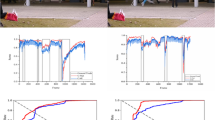Abstract
There are some the issues caused by the diversity and complexity of anomalous events in video, a sequence recognition-based video anomaly detection method is proposed to better extract feature vectors and carve anomaly boundaries to improve the detection accuracy. In order to avoid annotating unusual clips or clips in the training video, which is very time consuming, the weakly labeled is invoked to train videos. The normal and abnormal videos as a whole sequence are used to accomplish the anomaly detection task. First, the frame rate and size of the video are unified, and the video is decomposed into RGB frames and optical flow frames. Next, the I3D model will be used as a feature extraction model to extract the feature vector of the video from the decomposed video frames. And then the feature vector is input into the Bi-LSTM model to learn the context informations between video clips, and the hidden layer states of the Bi-LSTM model is encoded as the feature of the video. Finally, the encoded feature vectors are input to SR-Net to obtain the video anomaly score, and the anomaly score is used to detect whether there are anomalous events in the video. Theoretical analysis and experimental results show that the proposed method achieves a video-level AUC detection accuracy of 85.5% and a false alarm rate of 0.8 on the UCF-Crime dataset. Compared with previous algorithms for anomalous event detection based on multi-instance learning, the detection algorithm in this paper has a higher accuracy and a lower false alarm rate. The proposed method provides better detection results in video anomalous event detection tasks.
Access this chapter
Tax calculation will be finalised at checkout
Purchases are for personal use only
Similar content being viewed by others
References
Mohammadi, S., Perina, A., Kiani, H., Murino, V.: Angry crowds: detecting violent events in videos. In: Leibe, B., Matas, J., Sebe, N., Welling, M. (eds.) ECCV 2016. LNCS, vol. 9911, pp. 3–18. Springer, Cham (2016). https://doi.org/10.1007/978-3-319-46478-7_1
Rashmiranjan, N.F., Umesh, C.S., Santos, K.T.: A comprehensive review on deep learning-based methods for video anomaly detection. Image Vision Comput. 106 (2021). ISSN 0262-8856
Deepak, K., Srivathsan, G., Roshan, S.: Deep multi-view representation learning for video anomaly detection using spatiotemporal autoencoders. Circuits Syst. Sig. Process. 1333–1349 (2021)
Tran, D., Bourdev, L., Fergus, R.: Learning spatiotemporal features with 3D convolutional networks. In: 2015 IEEE International Conference on Computer Vision (ICCV), pp. 4489–4497 (2015)
Chu, W., Xue, H., Yao, C.: Sparse coding guided spatiotemporal feature learning for abnormal event detection in large videos. In: 2019 IEEE Transactions on Multimedia, vol. 21, no. 1, pp. 246–255 (2019)
Sultani, W., Chen, C., Shah, M.: Real-world anomaly detection in surveillance videos. In: 2018 IEEE/CVF Conference on Computer Vision and Pattern Recognition, pp. 6479–6488 (2018)
Zhong, J.X., Li, N., Kong, W.: Graph convolutional label noise cleaner: train a plug-and-play action classifier for anomaly detection. In: 2019 IEEE/CVF. Conference on Computer Vision and Pattern Recognition (CVPR), pp. 1237–1246 (2019)
Ionescu, R.T., Khan, F.S.,Georgescu, M.I.: Object-centric auto-encoders and dummy anomalies for abnormal event detection in video. In: 2019 IEEE/CVF Conference on Computer Vision and Pattern Recognition (CVPR), pp. 7834–7843 (2019)
Gong, D.: Memorizing normality to detect anomaly: memory-augmented deep autoencoder for unsupervised anomaly detection. In: 2019 IEEE/CVF International Conference on Computer Vision (ICCV), pp. 1705–1714 (2019)
Rodrigues, R., Bhargava, N., Velmurugan, R.: Multi-timescale trajectory prediction for abnormal human activity detection. In: 2020 IEEE Winter Conference on Applications of Computer Vision (WACV), pp. 2615–2623 (2020)
Morais, R., Le, V., Tran, T.: Learning regularity in skeleton trajectories for anomaly detection in videos. In: 2019 IEEE/CVF Conference on Computer Vision and Pattern Recognition (CVPR), pp. 11988–11996 (2019)
Carreira, J., Zisserman, A.: Quo vadis, action recognition? A new model and the kinetics dataset. In: 2017 IEEE Conference on Computer Vision and Pattern Recognition (CVPR), pp. 4724–4733 (2017)
Hasan, M., Choi, J., Neumann, J.: Learning temporal regularity in video sequences. In: 2016 IEEE Conference on Computer Vision and Pattern Recognition (CVPR), pp. 733–742 (2016)
He, Y., Zhao, J.: Temporal convolutional networks for anomaly detection in time series. J. Phys. Conf. Ser. 1213, 042050 (2019)
Wu, P., et al.: Not only look, but also listen: learning multimodal violence detection under weak supervision. In: Vedaldi, A., Bischof, H., Brox, T., Frahm, J.-M. (eds.) ECCV 2020. LNCS, vol. 12375, pp. 322–339. Springer, Cham (2020). https://doi.org/10.1007/978-3-030-58577-8_20
Liu, W., Luo, W., Lian, D.: Future frame prediction for anomaly detection - a new baseline. In: 2018 IEEE/CVF Conference on Computer Vision and Pattern Recognition, pp. 6536–6545 (2018)
Liu, W., Luo, W., Li, Z.: Margin learning embedded prediction for video anomaly detection with a few anomalies. In: Proceedings of the Twenty-Eighth International Joint Conference on Artificial Intelligence Main Track, pp. 3023–3030 (2019)
Narayan, S., Cholakkal, H., Khan, F.S.: 3C-Net: category count and center loss for weakly-supervised action localization. In: 2019 IEEE/CVF International Conference on Computer Vision (ICCV), pp. 8678–8686 (2019)
Acknowledgement
The authors thank the members of Machine Learning and Artificial Intelligence Laboratory, School of Computer Science and Technology, Wuhan University of Science and Technology, for their helpful discussion within seminars. This work was supported in part by National Natural Science Foundation of China (61972299, U1803262).
Author information
Authors and Affiliations
Corresponding author
Editor information
Editors and Affiliations
Rights and permissions
Copyright information
© 2022 The Author(s), under exclusive license to Springer Nature Switzerland AG
About this paper
Cite this paper
Yang, L., Zhang, X. (2022). A Video Anomaly Detection Method Based on Sequence Recognition. In: Huang, DS., Jo, KH., **g, J., Premaratne, P., Bevilacqua, V., Hussain, A. (eds) Intelligent Computing Theories and Application. ICIC 2022. Lecture Notes in Computer Science, vol 13394. Springer, Cham. https://doi.org/10.1007/978-3-031-13829-4_42
Download citation
DOI: https://doi.org/10.1007/978-3-031-13829-4_42
Published:
Publisher Name: Springer, Cham
Print ISBN: 978-3-031-13828-7
Online ISBN: 978-3-031-13829-4
eBook Packages: Computer ScienceComputer Science (R0)




